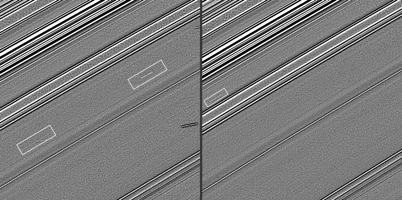New Views on Old Finds
Caption:

Annotated Image
These two Cassini images, taken four years before Saturn's August 2009 equinox, have taken on a new significance as data gathered at equinox indicate the streaks in these images are likely evidence of impacts into the planet's rings.
The images, which were taken 14 minutes apart and have been specially processed to bring out fine details, show distinct streaks in Saturn's C ring. In the left-hand image, the streaks that are nearly horizontal are background stars elongated by the spacecraft's motion during the exposure. (The ring features in these images are not smeared because, in general, the spacecraft's camera is turned during imaging exposures to track the motion of Saturn and its rings.) But the two streaks which are parallel to the other ring features in the image (one of which intersects a star trail) and situated in the central bland region of the frame are believed to be the result of impacts.
The lengths of these features are determined by the impact site's orbital motion (from upper right to lower left) during the duration of the exposure, as well as orbital shear that elongates and tilts (relative to the orbital direction) the cloud of ejecta. In these images, the former is much larger than the latter, indicating that these impacts are probably recent (less than one day old).
These C-ring ejecta clouds are feebler than impacts found during equinox (see
PIA11674
), an observation that is consistent with the impactors being much smaller than 1 meter (3 feet). The visibility of these faint, narrow features is considerably increased by the high-phase-angle (171 degrees) viewing conditions, which enhance the visibility of fine dust.
Together with sightings of streaks in the A and C rings during equinox, these observations constitute the first visual confirmation of a long-held belief that bits of interplanetary debris continually rain down on Saturn's rings and contribute to the rings' erosion and evolution.
These two images were processed with a high-pass filter to expose the streaks, making the rings appear grainier and brighter than in the original versions. This view looks toward the unilluminated side of the rings from about 19 degrees above the ring plane.
The images were taken in visible light with the Cassini spacecraft narrow-angle camera on May 3, 2005. The view was obtained at a distance of approximately 272,000 kilometers (169,000 miles) from Saturn and at a Sun-Saturn-spacecraft, or phase, angle of 171 degrees. Image scale is 1 kilometer (4,155 feet) per pixel.
Background Info:
The Cassini-Huygens mission is a cooperative project of NASA, the European Space Agency and the Italian Space Agency. The Jet Propulsion Laboratory, a division of the California Institute of Technology in Pasadena, manages the mission for NASA's Science Mission Directorate, Washington, D.C. The Cassini orbiter and its two onboard cameras were designed, developed and assembled at JPL. The imaging operations center is based at the Space Science Institute in Boulder, Colo.
For more information about the Cassini-Huygens mission visit
http://saturn.jpl.nasa.gov/
. The Cassini imaging team homepage is at
http://ciclops.org
.
Cataloging Keywords:
| Name |
Value |
Additional Values |
| Target |
Saturn Rings |
A Ring, C Ring, Saturn |
| System |
Saturn |
|
| Target Type |
Ring |
Planet |
| Mission |
Cassini-Huygens |
|
| Instrument Host |
Cassini Orbiter |
|
| Host Type |
Orbiter |
|
| Instrument |
Imaging Science Subsystem (ISS) |
|
| Detector |
Narrow Angle Camera |
|
| Extra Keywords |
Dust, Grayscale, Impact, Visual |
| Acquisition Date |
|
| Release Date |
2009-09-21 |
| Date in Caption |
2005-05-03 |
|
| Image Credit |
NASA/JPL/Space Science Institute |
| Source |
photojournal.jpl.nasa.gov/catalog/PIA11675 |
| Identifier |
PIA11675 |

 Planetary Data System
Planetary Data System

